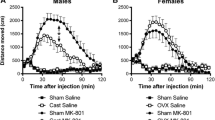Abstract
Placing of receptive females in the sector of a cage separated by a partition preventing physical contact but allowing sight and olfaction induced increases in blood testosterone levels in male mice. The selective agonist of 5-HT1A receptors 8-OH-DPAT (0.1 mg/kg) and the mixed 5-HT1A/1B receptor agonist eltoprazine (3.0 and 10.0 mg/kg) blocked the activatory effect of presentation of females on the hypothalamo-hypophyseal-testicular complex (HHTC) in males, while the 5-HT1A receptor antagonist p-MPPI (0.2 mg/kg) prevented the inhibitory effects of 8-OH-DPAT and eltoprazine. The 5-HT1B receptor agonist CGS-12066A (1.0 and 2.0 mg/kg) had no effect, while the mixed 5-HT1B/2C agonist TFMPP (5.0 mg/kg) blocked the increase in blood testosterone in males in response to presentation of females. The 5-HT2A receptor antagonist ketanserin (1.0 and 2.0 mg/kg) prevented the increase in testosterone induced by the presence of females. The 5-HT3 receptor antagonist ondansetron (0.05 and 0.1 mg/kg) increased the initial plasma testosterone level but blocked activation of the HHTC induced by the presence of receptive females. These results led to the conclusion that 5-HT receptors are involved in controlling the sexual activation of males. Different types and even subtypes of the same type of 5-HT receptor had different effects, both inhibitory and activatory, on activation of the HHTC by receptive females. Blockade of HHTC activation induced by the presence of females appears to involve 5-HT1A and 5-HT2C receptors, while activation involves 5-HT2A and 5-HT3 receptors.
Similar content being viewed by others

REFERENCES
T. G. Amstislavskaya, A. V. Osadchuk, and E. V. Naumenko, Probl. Éndokrinol., 35, No. 6, 63–66 (1989).
S. N. Novikov, Pheromones and Reproduction in Mammals [in Russian], Leningrad (1988).
A. V. Osadchuk and E. V. Naumenko, Dokl. Akad. Nauk SSSR, 258, No. 3, 746–749 (1981).
N. K. Popova, T. G. Amstislavskaya, and S. A. Kucheryavyi, Zh. Vyssh. Nerv. Deyat., 48, No. 1, 84–90 (1998).
S. Ahlenius, K. Larsson, and A. Wijkstrom, Eur. J. Pharmacol., 210, No. 2-3, 259–266 (1991).
N. M. Barnes and T. Sharp, Neuropharmacology, 39, No. 8, 1083–1152 (1999).
G. Baxter, G. Kennett, F. Blaney, and T. Blackburn, Trends Pharmacol. Sci., 16, No. 3, 105–110 (1995).
G. Griebel, Pharmacol. Ther., 65, 319–395 (1995).
D. Hoyer, D. E. Clarke, J. R. Fozard, et al., Pharmacol. Rev., 46, No. 2, 157–200 (1994).
M. P. Kung, D. Frederick, M. Mu, et al., J. Pharmacol. Exptl. Ther., 272, 429–437 (1995).
N. Kurtz, Serotonin 1A Receptors in Depression and Anxiety, S. M. Stahl et al. (eds.), New York (1992), pp. 163–170.
E. V. Naumenko, T. G. Amstislavskaya, and A. V. Osadchuk, Exptl. Clin. Endocrinol., 97, 1–12 (1991).
R. F. Neale, S. Fallon, W. Boyar, Eur. J. Pharmacol., 136, 1–9 (1987).
M. Rodriguez, R. Castro, G. Hernandez, and M. Mas, Physiol Behav., 33, No. 1, 5 (1984).
H. W. M. Steinbusch and R. Nieuwenhuys, Serotonin: Current Aspects of Neurochemistry and Function, B. Haber et al. (eds.), New York (1981).
Rights and permissions
About this article
Cite this article
Amstislavskaya, T.G., Popova, N.K. The Roles of Different Types of Serotonin Receptors in Activation of the Hypophyseal-Testicular Complex Induced in Mice by the Presence of a Female. Neurosci Behav Physiol 34, 833–837 (2004). https://doi.org/10.1023/B:NEAB.0000038136.27999.3d
Issue Date:
DOI: https://doi.org/10.1023/B:NEAB.0000038136.27999.3d



